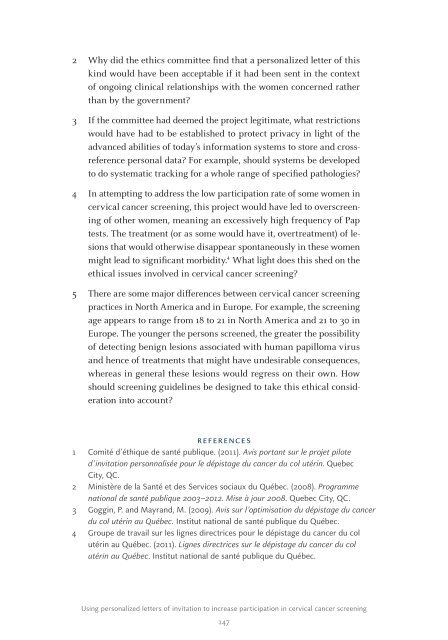PoPulationand Public HealtH etHics
PoPulationand Public HealtH etHics
PoPulationand Public HealtH etHics
Create successful ePaper yourself
Turn your PDF publications into a flip-book with our unique Google optimized e-Paper software.
2 Why did the ethics committee find that a personalized letter of this<br />
kind would have been acceptable if it had been sent in the context<br />
of ongoing clinical relationships with the women concerned rather<br />
than by the government?<br />
3 If the committee had deemed the project legitimate, what restrictions<br />
would have had to be established to protect privacy in light of the<br />
advanced abilities of today’s information systems to store and crossreference<br />
personal data? For example, should systems be developed<br />
to do systematic tracking for a whole range of specified pathologies?<br />
4 In attempting to address the low participation rate of some women in<br />
cervical cancer screening, this project would have led to overscreening<br />
of other women, meaning an excessively high frequency of Pap<br />
tests. The treatment (or as some would have it, overtreatment) of lesions<br />
that would otherwise disappear spontaneously in these women<br />
might lead to significant morbidity. 4 What light does this shed on the<br />
ethical issues involved in cervical cancer screening?<br />
5 There are some major differences between cervical cancer screening<br />
practices in North America and in Europe. For example, the screening<br />
age appears to range from 18 to 21 in North America and 21 to 30 in<br />
Europe. The younger the persons screened, the greater the possibility<br />
of detecting benign lesions associated with human papilloma virus<br />
and hence of treatments that might have undesirable consequences,<br />
whereas in general these lesions would regress on their own. How<br />
should screening guidelines be designed to take this ethical consideration<br />
into account?<br />
reFerences<br />
1 Comité d’éthique de santé publique. (2011). Avis portant sur le projet pilote<br />
d’invitation personnalisée pour le dépistage du cancer du col utérin. Quebec<br />
City, QC.<br />
2 Ministère de la Santé et des Services sociaux du Québec. (2008). Programme<br />
national de santé publique 2003–2012. Mise à jour 2008. Quebec City, QC.<br />
3 Goggin, P. and Mayrand, M. (2009). Avis sur l’optimisation du dépistage du cancer<br />
du col utérin au Québec. Institut national de santé publique du Québec.<br />
4 Groupe de travail sur les lignes directrices pour le dépistage du cancer du col<br />
utérin au Québec. (2011). Lignes directrices sur le dépistage du cancer du col<br />
utérin au Québec. Institut national de santé publique du Québec.<br />
Using personalized letters of invitation to increase participation in cervical cancer screening<br />
147
















